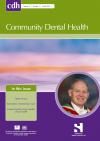Community Dental Health

- Cover Date:
- March 2015
- Print ISSN:
- 0265 539X
- Vol:
- 32
- Issue:
- 1
The relationship between tooth loss and psychological factors
© BASCD 2015 doi:10.1922/CDH_3396Afshar04
The relationship between tooth loss and psychological factors
H. Roohafza, P. Afghari, A. Hassanzadeh Keshteli, A. Vali, M. Shirani, P. Adibi and H. Afshar
Objectives: Limited evidence is available regarding mutual interactions between psychological factors and tooth loss. This study aimed to investigate the association between these two issues. Method: In this 2011cross-sectional study we obtained data from 4,585 adults who had completed information in 20 counties across Isfahan province, Iran, regarding tooth loss and psychological factors (depression, anxiety and stress level). To analyse the data ANOVA and multiple ordinal regression were applied. Results: After adjusting socio demographic factors, the association between depression (OR 1.23; 95%CI=1.01,1.49), anxiety (OR 1.19; 95%CI=1.03,1.38), and high stress level (OR 95%CI=1.19; 1.01,1.39) remained significant. Conclusion: We confirm the interaction between psychological factors and tooth loss, but recommend further studies on a national Iranian population.
Key words: tooth loss, stress, depression, anxiety, Iran
- Article Price
- £15.00
- Institution Article Price
- £
- Page Start
- 16
- Page End
- 19
- Authors
- H. Roohafza, P. Afghari, A. Hassanzadeh Keshteli, A. Vali, M. Shirani, P. Adibi, H. Afshar
Articles from this issue
- Title
- Pg. Start
- Pg. End
- Comparing lifecourse models of social class and adult oral health using the 1958 National Child Development Study
- 20
- 25
- Barriers to providing oral health care to pre-school children– differences between paediatric dentists’ and general dental practitioners’ beliefs
- 32
- 38
- Health economic analyses of domiciliary dental care and care at fixed clinics for elderly nursing home residents in Sweden
- 39
- 43
- Tooth brushing among 11- to 15-year-olds in Denmark: combined effect of social class and migration status.
- 51
- 55
- The incidence and nature of complaints against dentists for the treatment of children in Israel from 1992–2011
- 56
- 59
